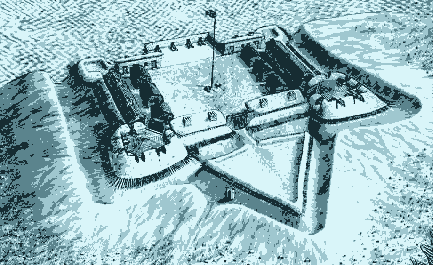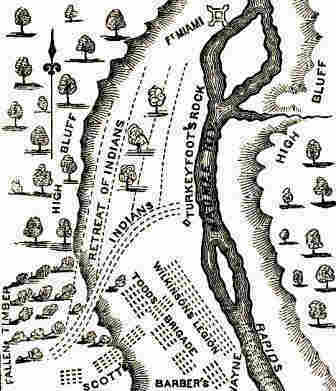
Fort Miami was built by the British in 1794 as an effort to resist the United States in their plans to formally conquer contested areas of the Northwest Territory. The now long-gone fortification was constructed in modern day Maumee, Ohio on the Maumee River. Fort Miami played a key role in British-Indian relations of the time as well as United States land acquisition in the North.
In 1794, Anthony Wayne and the Legion of the United States advanced against a union of Ohio Valley and Great Lakes area Native American Tribes including the Shawnees, Delawares, Wyandots, Miamis, Ottawas, Ojibwas, Mingos, and Potawatomis. This movement sparked the order to build and garrison a fort by the British colony in Canada, specifically Canada’s Governor in Chief Lord Dorchester. Even though the order to build a fort was given by Dorchester, the location of the post was decided by Lieutenant Governor John G. Simcoe [4]. Fort Miami was built to stop the United States from dominating the region both politically and economically. The structure was started in April and finished in August of 1794 and included a twenty-five foot deep trench lined with wooden spears to impede enemy invasion. Fort Miami had four diamond shaped outcrops constructed from rocks and soil called bastions. There were also fourteen cannons within the fort to defend against long range assault.
The Battle of Fallen Timbers
On August 20th, 1794 the final battle of the Northwest Indian War, the battle of Fallen Timbers commenced. The American soldiers led by Anthony Wayne managed to defeat the Native warriors. After this success, Wayne trailed the retreating Indians until he had reached the artillery range of Fort Miami [7]. At this point, both the British and Americans wanted to avoid conflict with each other. The Americans ordered the British to surrender the fortification and to pull forces out of the area, but the British refused to do so. After this, the Legion fell back and the British continued to reinforce Fort Miami as they still saw it as an important focal point to resisting the United States in conquering the Northwest Territory.

A very important role of Fort Miami was how it affected the relationship between the British and the Native people of the region. The British had the wrong idea about the plans of Anthony Wayne. Wayne’s goal in 1794 was to triumph over the Native population near the Maumee River rather than move north and try to overtake Detroit as the British were expecting [5]. In order to keep benefiting from the fur trade, the British had to maintain a good relationship with the American Indians. Even knowing this, as Anthony Wayne advanced against the Native union in August of 1794, the British garrisoning Fort Miami refused to support the Natives despite their requests. At the battle of Fallen Timbers, as mentioned earlier, Anthony Wayne’s soldiers forced the Ohio American Indians to retreat. The Indians fell back to Fort Miami in hope of British assistance. The Royal forces denied the Natives entrance to the fort and also had no intention of supporting them with firepower [6]. This refusal of protection and support in a time of need for the Ohio American Indians was detrimental to British-Indian relations in the Great Lakes region.
Peace and Fort Miami
The Battle of Fallen Timbers near Fort Miami actually led to peace between the American Indians and the United States. The tribes that signed the Treaty of Greenville include the Wyandots, Delawares, Shawanees, Ottawas, Chippewas, Pattawatimas, Miamis, Eel Rivers, Weas, Kickapoos, Piankeshaws, and Kaskaskias. The document of peace is known as the Treaty of Greenville, deriving its name by being signed at Fort Greenville, was signed on August 3rd 1795, just short of a year after the battle. The aim of the document, as written in its opening statements, was “To put an end to a destructive war, to settle all controversies, and to restore harmony and friendly intercourse between the said United States and Indian tribes…” [1]. The treaty goes on to mention Anthony Wayne as well as the United States Military. Furthermore, the document sets boundaries for the United States as well as the Indians. These boundaries seemingly accomplish the goal of the British at Fort Miami by keeping the United States from conquering the northern Midwest. One more thing worth mentioning is the fact that this treaty was signed after a battle where the British played a pivotal role in the Native American loss. This begs the question, did the British accidentally help the United States come to peaceful terms with the native tribes of the Midwest?
The British stationed at Fort Miami chose not to help the retreating Indians even though they knew Indian relationships were vital to the fur trade. This choice may have made the British just as unappealing to the native tribes as the Americans that were marching against them [4]. Then came the Treaty of Greenville, an attempt to mend American-Native relations, which could have made the Indians think that the Americans were the proper party to trust over the British. Basically, neither the British or the Americans had made themselves favorable choices to continue trading with, but the Americans had made the most recent attempts at peace and mutual prosperity.
Political Climate
On December 8th 1795, President George Washington gave the State of the Union address. In the address, President Washington speaks about General Anthony Wayne’s victory over the Indians in North Ohio. The President also states that this proves the United States’ military superiority over the “savages” of the region and across the nation. After that, he speaks about how the United States has the unquestionable power to punish the tribes, but will work with them to create lasting peace on terms that satisfy all parties involved [2]. This part of the address shows a bit about the relationship between the United States and the Indians in the era of Fort Miami. The United States clearly had the intention to expand their current land possession and did do so, but would be willing to limit their expansion for the time being in order to maintain a peaceful relationship with the native tribes [8]. Although this may have been the case, the United States still wanted to show the Indians that Wayne’s army was superior to their own without question. Fort Miami is a clear example of this intimidation. Perhaps if Wayne’s troops had followed through and continued attack on the Ohio Indians in 1794 the intimidation would still have been effective to the tribes of the area, but the possibility for peace may have been much slimmer. There was a fine line between intimidation followed by peace and intimidation followed by hostile action or war. This line would be the definition between an act of aggression by the United States, such as total elimination of a tribe, that could not be forgiven by the Native Americans.
Aside from Indian relations between the British and the United States in the Great Lakes region, Fort Miami was also part of affairs between the British and the United States. Jay’s Treaty, officially titled “Treaty of Amity Commerce and Navigation, between His Britannic Majesty; and The United States of America”, was a treaty between the United States and Great Britain signed on November 19th, 1794. The treaty was about many things including wartime debt and British-American trade [3]. However, the most relevant topic to Fort Miami was the complete removal of British troops from the Northwest Territory. Jay’s Treaty meant that the British had to vacate six of its forts, including Fort Miami that were in the region of the Great Lakes as well as two others. Fort Miami was seen by the British as their last line of defense against the United States conquering the northern Great Lakes region. The vacating of the fortification meant that the United States was able to do as it pleased in the area assuming they could conquer the Indians, which had not been a problem before.
Fort Miami was a key military occupation site for the British, a turning point of British and Indian relations in the Great Lakes area, and a piece of American political victory. The fort itself was part of a much bigger transition from passive aggressive standoffs between the United States and Britain to war reparation, trade, and the removal of British troops from American controlled territory. The Americans also made peaceful compromises with the native tribes in the Midwest to take some territories but set a border for the United States to obey as well. Fort Miami is a small part of American military history in the Upper Great Lakes region, but its importance should not be overlooked.

Primary Sources
- “Treaty of Greenville”. August 3, 1795. Vol. 20, (1892): 410-419.
- Washington, George “State of the Union Address.” 1795 State of the Union. Washington DC. December 8, 1795.
- “John Jay’s Treaty, 1794-95.” U.S. Department of State. November 19, 1794.
Secondary Sources
- Pratt, G. Michael (1984). The Rise and Fall of Fort Miami. Tiffin, OH: Heidelberg College.
- Horsman, Reginald (1962). The British Indian Department and the Resistance to General Anthony Wayne.
- Hurt, R. Douglas (1996). The Ohio Frontier: Crucible of the Old Northwest, 1720-1830. Bloomington, IN: Indiana University Press.
- Hass, Fred T. (1920). Ohio Archaeological and Historical Publications Volume 29: 390-411.
- Central Michigan University (2017). “The Battle of Fallen Timbers.” Clarke Historical Library.
